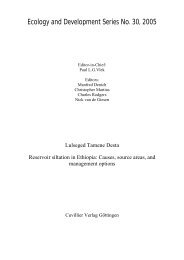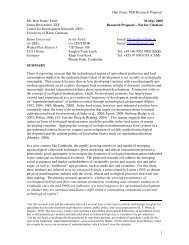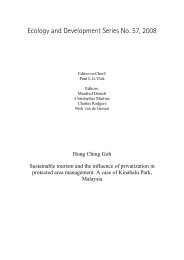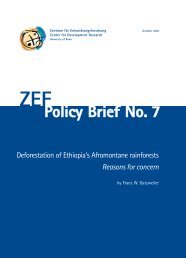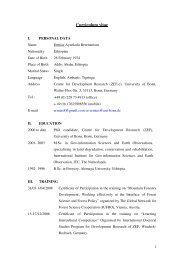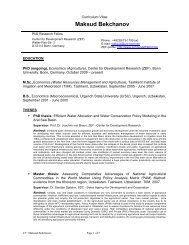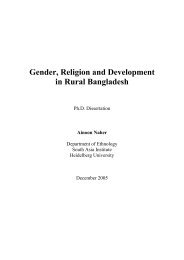Ecology and Development Series No. 10, 2003 - ZEF
Ecology and Development Series No. 10, 2003 - ZEF
Ecology and Development Series No. 10, 2003 - ZEF
- No tags were found...
You also want an ePaper? Increase the reach of your titles
YUMPU automatically turns print PDFs into web optimized ePapers that Google loves.
Impacts of human use on the forest vegetationIn all height classes, the three managed forest categories (SEMIFOR-NEW,SEMIFOR-OLD, <strong>and</strong> SEMIFOR-PLAN) were significantly different from both NATFOR<strong>and</strong> SECFOR in terms of the abundance of stems per plot of 400 m 2 (Table 5.<strong>10</strong>.). Thedifference was very highly significant in height classes 1 <strong>and</strong> 2 (HC1 <strong>and</strong> HC2). The meanabundances in HC 2 <strong>and</strong> HC 3 of undisturbed forests, NATFOR <strong>and</strong> SECFOR, were almostten-fold of the abundance of similar height classes in the three managed forest categories(Table 5.<strong>10</strong>). Likewise, abundances in HC 4 of the undisturbed forests were also at leastfour-fold of the abundances in the managed forests of the same height class.Table 5.<strong>10</strong>. Test of differences in abundance of stems in different height classes, usingMann-Whitney U-test. The levels of significance indicated by asterix, as * = P< 0.05; ** = P < 0.01; *** = P < 0.001, <strong>and</strong> NS = not significant. Meanabundance is the average number of stems per 400 m 2 sample plot.12345HC 1 HC 2 HC 3 HC 41 2 3 4 5 1 2 3 4 5 1 2 3 4 5 1 2 3 4 5Mean abundance 2927 2766 1908 1419 837 425 563 42 36 97 32 21 3 2 3 8 8 2 2 0.1NATFORSECFOR NS NS NS NSSEMIFOR-NEW * * *** *** *** *** * **SEMIFOR-OLD *** *** NS *** *** NS *** *** * * *** NSSEMIFOR-PLAN *** *** ** NS *** *** NS NS *** *** NS NS *** *** *** **On the other h<strong>and</strong>, there was no significant difference between NATFOR <strong>and</strong>SECFOR in all height classes (Table 5.13.). The three managed forest categories weresimilar to each other in the abundances of HC 2. The SEMIFOR-NEW differs significantlyfrom the SEMIFOR-PLAN in HC 1 <strong>and</strong> HC 4. The SEMIFOR-NEW <strong>and</strong> SEMIFOR-OLDdiffered from each other in HC 3 only. The SEMIFOR-PLAN differed significantly fromSEMIFOR-NEW <strong>and</strong> SEMIFOR-OLD in HC 4.5.3.5 Changes in basal areaThe comparisons of the basal areas (BA) of the five forest categories are presented in Table5.11 below. The test static used in this case is the paired t-test, since the BA is a continuousmeasured variable as compared to abundance, which is count data. The forest categoriesdiffered significantly in their BA (F 4,45 = 3.78; P < 0.01; Appendix 6).89





